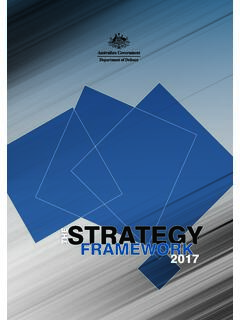Transcription of OFX Implementation Guide
1 OFX Implementation Guide 0 OFX Implementation Guide For OFX and OAuth OFX Consortium OFX Implementation Guide 0 Table of Contents Scope of 2 OAuth is an Elegant Solution .. 3 OFX Features .. 4 OAuth Features .. 5 OAuth 2 Implementation Flow .. 6 Roles .. 7 Implementing a Security Token with an OFX Server .. 8 About ACCESSTOKEN .. 8 Signon Realms .. 9 Implementing an OAuth Enabled Client .. 10 Suggested Practices .. 10 Out-of-Band Communication Topics .. 11 Step-by-Step Guides for Implementing OAuth with OFX .. 12 Enable an OFX Client To Communicate With an OFX 12 Enable an OFX Server to Communicate With an OAuth Client .. 13 Sample Implementation .. 14 Sign On .. 14 Sign Up (Account Info) .. 16 Credit Card Statement Download .. 18 Bank Statement Download .. 20 Error Handling.
2 22 Example <CODE>15514 Response .. 23 Example <CODE>15515 Response .. 24 Example <CODE>15516 Response .. 25 Important Considerations for Implementations .. 26 Appendix .. 27 Acronyms .. 27 Glossary .. 27 Resources .. 27 OFX Implementation Guide 1 Version History Date Author Version Description June 1, 2016 Ernest Riley, Enterprise Engineering, Inc. Rodelio Pagui , Enterprise Engineering, Inc. Initial Release July 6, 2016 Ernest Riley, Enterprise Engineering, Inc. 6-23 Edit memo updates OFX Implementation Guide 2 Scope of Document This Implementation Guide illustrates best practices and Implementation considerations for OFX and for out-of-band, security token-based authentication, specifically, OAuth The Implementation Guide highlights the following: Current issues that financial management products and Financial Institutions (FIs) face in acquiring and provisioning users financial data over the Internet.
3 Use of OAuth with OFX , and how it solves the issues described above. Changes in OFX spec to accommodate out-of-band OAuth security token. The intended audience of this Implementation Guide is expected to have knowledge of OAuth framework and the OFX protocol. For more information on OAuth and OFX , please check the Resources section of this document. OFX Implementation Guide 3 OAuth is an Elegant Solution Below are some of the issues that financial management products face in obtaining a user s financial data over the Internet. This isn t an exhaustive list, but describes the main issues being addressed by this type of Implementation . 1. The need to store FI credentials in third-party systems that expose FIs and financial management systems to liabilities associated with potential breach of those credentials.
4 2. Management and provisioning of credentials across multiple systems result in poor user experience and higher customer service costs. While OFX credentials can be narrowly scoped, , limited to data downloads only, to mitigate the impact of data breach, they still need to be managed. For example, changes in password have to be manually transferred over to any client system that uses the credentials. OAuth provides an elegant solution to the above problems by ensuring that the customer only ever needs to share credentials with their FI. Once the FI has validated the user credentials, the FI can enable registered OFX clients to access the users data. Issues Solution(s) Screen scraping of websites Provide a OFX channel using OAuth token-based authentication, which relieves the stress on websites and allows for screen scraping entities to achieve optimal performance.
5 Authentication performed after OFX request is received by network OAuth authentication adds an additional layer of security by proxy authentication. OFX Implementation Guide 4 OFX Features Features Benefits Open Financial Exchange, OFX Low-cost delivery channel Lower costs and simpler Implementation Financial institutions can choose any OFX Solution Provider that supports the specification or develop their own OFX-compliant server to process transactions internally Freedom of choice OFX eliminates connectivity as an obstacle to the growth of online banking and financial services, thus promoting competition on the basis of product, price and service. Choice of services Financial institutions can choose from banking, bill payment, investments, and bill presentment. Choice of technology partners To simplify the process of connecting to customers, financial institutions can choose a system integrator to develop a server or choose a service bureau to outsource banking, bill payment, and other services.
6 Choice of hardware and software Financial institutions can use many combinations of hardware and software to support OFX. Integration of OAuth Support Using OFX , personal financial management software can connect with OAuth provided credentials to a financial institution s OFX server. With OAuth, credentials provided by an OAuth provider, or server, will be used to confirm access to perform financial transactions. OFX Implementation Guide 5 OAuth Features Features Benefits Fewer passwords for end-user to remember Using a well-known OAuth provider, a financial institution gives their clients the option to leverage their existing service credentials to access their financial data. Reduced Support Surrounding Authentication Save time and resources surrounding support of authentication.
7 Reduced Authentication Failures. Reduced failures related to login will allow support personnel to concentrate efforts elsewhere concerning application support. An addition benefit is that the end-user has one less password to remember. Permission Management Easier management of permissions at a client and data level. Two-legged Authentication A pre-approved application is allowed to access available resources. Three-legged Authentication A resource owner uses a pre-approved application to access available resources. OFX Implementation Guide 6 OAuth 2 Implementation Flow OAuth 2 Authorization Code Grant The Authorization Code Grant works in the following manner: 1) The client application sends an authorization request to the OAuth Server s authorization endpoint/page. 2) The resource owner (user) enters his credentials.
8 3) The resource owner confirms that he is allowing the client application to access his protected resources (OFX) in the specified/requested scope. 4) The client application will now use authorization code received in exchange for an Access Token and an optional Refresh Token. 5) The client application will now use the Access Token to access the protected resource. OFX Implementation Guide 7 Roles Role Description End-User, or Resource Owner Examples: Financial Institution client accessing FinTech application. Financial Institution, FI Brokerages, etc., that hold the end-users financial data. Protected Resource, namely OFX Server Interface used by FIs to expose and end-users financial data. Client Application Application used by end-user to view their financial data. OAuth Server Intermediate resource used to prevent the client application having to handle an end-user s credentials, therefore, adding an additional layer of security.
9 OFX Implementation Guide 8 Implementing a Security Token with an OFX Server Part of the two-way exchange for financial data includes authentication. Typically, a username and password is provided as part of each OFX request. As such, the OFX server is responsible for performing the authentication of the provided credentials. With OAuth, the authentication is performed by the OAuth server, leaving the OFX server to perform the financial transaction. One of the features added for OFX is the ability to use an OAuth access token in an OFX request. About ACCESSTOKEN Servers may require the use of an <ACCESSTOKEN> in place of <USERID> and <USERPASS> for authentication. The use and format of <ACCESSTOKEN> must be arranged out-of-band between the client and the OFX Server provider.
10 Keeping the specific use and format of <ACCESSTOKEN> out-of-band allows OFX to support numerous methods of token generation such as OAUTH , OAUTH , JSON Tokens and so on. Essentially any agreed-upon token format and methodology may be used between the client and server. The intent of <ACCESSTOKEN> is to leverage an out-of-band mechanism that will fully replace all other types of authentication within OFX for all types of accounts and requests. As such, <ACCESSTOKEN> interaction with other <SONRQ> mechanisms and features should be avoided. A client should send ONLY one of the following for authentication: 1. <USERID> and <USERPASS>; 2. <USERKEY>; or 3. <ACCESSTOKEN> Via out-of-band communication, or outside of the OFX channel, the client application developer acquires the security token from the Financial Institution and is not discussed within this Implementation Guide .






